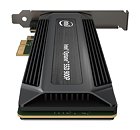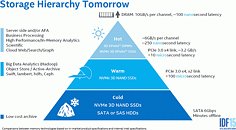Monday, November 13th 2017

Intel, Micron Increase 3D XPoint Manufacturing Capacity Through Fab Expansion
Today, Intel and Micron announced the completion of an expansion to Building 60 (B60) at the IM Flash facilities in Lehi, Utah. The expanded fab will produce 3D XPoint memory media, a building block of Intel Optane technology that includes Intel Optane memory for clients, the recently announced Intel Optane SSD 900P Series and new capacities and form factors of the Intel Optane SSD DC P4800X Series. A ribbon-cutting was held at the facility with Utah Gov. Gary Herbert, employees of the facility and representatives from Intel and Micron.
The IM Flash joint venture was created in 2006 to manufacture non-volatile memory for both Intel and Micron, starting with NAND for use in SSDs, phones, tablets and more. In 2015, IM Flash began manufacturing 3D XPoint technology, the first entirely new memory media in 25 years. The technology was developed to meet the quickly expanding data needs for all types of customers. 3D XPoint technology uses a crosspoint structure to deliver a cell and array architecture that can switch states significantly faster than NAND."Intel Optane technology is changing the way we interact with the incredible amounts of data being created every day, and this expansion will help us meet demand for the extraordinary products we've introduced this year and the exciting roadmap ahead," said Rob Crooke, senior vice president and general manager of the Non-Volatile Memory (NVM) Solutions Group at Intel Corporation. "When we bring data closer to the CPU and enable blisteringly fast access to that data, we can empower customers to create incredible experiences and deliver data results we've never had before - faster MRIs, smoother gaming experiences, real time analytics and so much more."
Intel recently announced the Intel Optane SSD 900P Series for use in desktop and workstation PCs. It delivers incredibly low latency and best-in-class random read and write performance at low queue depths. Additionally, Intel expanded the Intel Optane technology offerings for the data center, introducing 750GB capacity and 2.5-inch U.2 form factor versions of the Intel Optane SSD DC P4800X Series.
Source:
Intel News Room
The IM Flash joint venture was created in 2006 to manufacture non-volatile memory for both Intel and Micron, starting with NAND for use in SSDs, phones, tablets and more. In 2015, IM Flash began manufacturing 3D XPoint technology, the first entirely new memory media in 25 years. The technology was developed to meet the quickly expanding data needs for all types of customers. 3D XPoint technology uses a crosspoint structure to deliver a cell and array architecture that can switch states significantly faster than NAND."Intel Optane technology is changing the way we interact with the incredible amounts of data being created every day, and this expansion will help us meet demand for the extraordinary products we've introduced this year and the exciting roadmap ahead," said Rob Crooke, senior vice president and general manager of the Non-Volatile Memory (NVM) Solutions Group at Intel Corporation. "When we bring data closer to the CPU and enable blisteringly fast access to that data, we can empower customers to create incredible experiences and deliver data results we've never had before - faster MRIs, smoother gaming experiences, real time analytics and so much more."
Intel recently announced the Intel Optane SSD 900P Series for use in desktop and workstation PCs. It delivers incredibly low latency and best-in-class random read and write performance at low queue depths. Additionally, Intel expanded the Intel Optane technology offerings for the data center, introducing 750GB capacity and 2.5-inch U.2 form factor versions of the Intel Optane SSD DC P4800X Series.


5 Comments on Intel, Micron Increase 3D XPoint Manufacturing Capacity Through Fab Expansion
Sweet drives btw. Weird that we haven't seen a Micron product yet though.
I wonder if Intel has anything to do with it.
Intel also just released the 545s for lower end SATA (but 64 layer), and Micron hasn't done that as well.